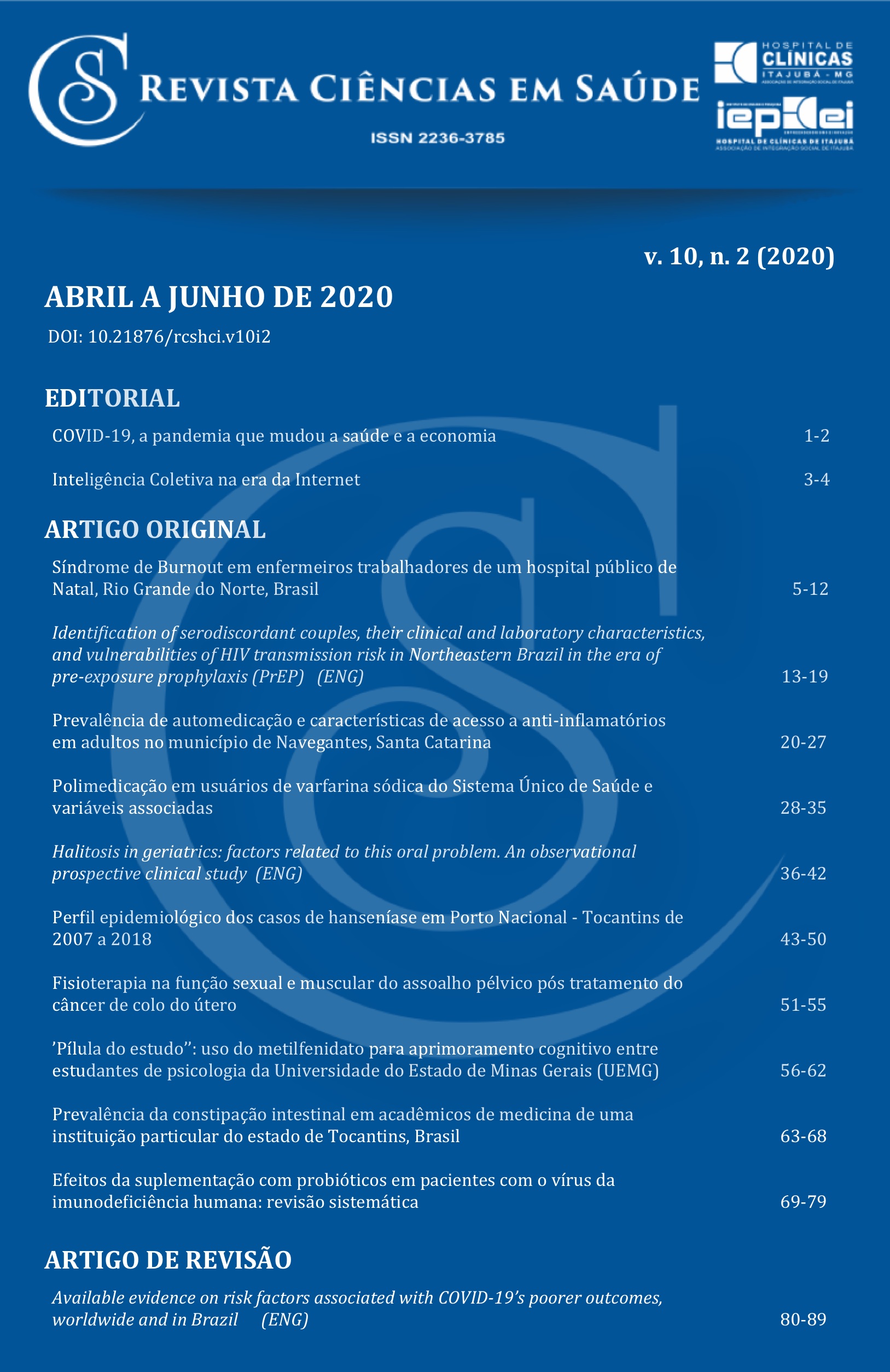Halitosis in geriatrics: factors related to this oral problem. An observational prospective clinical study.
Main Article Content
Abstract
Objective: To identify the presence and level of halitosis in edentulous individuals with or without prostheses, before and after rehabilitation with complete dentures (CD). Methods: Patients were verbally invited to participate and signed an Informed Consent. Halitosis was analyzed by the volatile sulfur compounds measurement method in the presence and absence of the old prostheses (M1) and 15 to 30 days after the patients received their new prostheses (M2). At M1, the patients answered a questionnaire with clinical data, and the saliva type and presence/absence of tongue coating were assessed. T-test and Spearman correlation test were used, and a p-value < 0,05 was considered statistically significant. Results: Twenty-seven patients (19 women) with an average age of 67 years participated in the study. The mean time of prosthesis usage was 20.2 years. Tong coating was present in 21 patients (77,8%). A good odor level of halitosis was self-claimed in 13 (41,8%) individuals. The odor level of halitosis was significantly lower in M2 compared to M1, either with or without CD and after hygiene (p < 0,001). There was a positive and statistically significant correlation between the level of halitosis and alcoholism, smoking, prostheses hygiene method, and the presence of disease (diabetes). Conclusion: The old complete replacement of the prostheses with new ones was able to improve the odor level in a period of 15 to 30 days after the treatment. The presence of halitosis was correlated with alcoholism, smoking, denture hygiene methods, and the presence of diabetes.
Article Details
Authors maintain copyright and grant the HSJ the right to first publication. From 2024, the publications wiil be licensed under Attribution 4.0 International 
 , allowing their sharing, recognizing the authorship and initial publication in this journal.
, allowing their sharing, recognizing the authorship and initial publication in this journal.
Authors are authorized to assume additional contracts separately for the non-exclusive distribution of the version of the work published in this journal (e.g., publishing in an institutional repository or as a book chapter), with acknowledgment of authorship and initial publication in this journal.
Authors are encouraged to publish and distribute their work online (e.g., in institutional repositories or on their personal page) at any point after the editorial process.
Also, the AUTHOR is informed and consents that the HSJ can incorporate his article into existing or future scientific databases and indexers, under the conditions defined by the latter at all times, which will involve, at least, the possibility that the holders of these databases can perform the following actions on the article.
References
Aydin M, Harvey-Woodworth CN. Halitosis: a new definition and classification. Br Dent J. 2014;217(1):E1. doi: 10.1038/sj.bdj.2014.552
Cortelli JR, Barbosa MDS, Westphal MA. Halitosis: review of associated factors and therapeutic approach. Braz Oral Res [Internet]. 2008 [cited 2020 May 13];22(Spec Iss 1):44-54. Avaiable from: www.scielo.br/pdf/bor/v22s1/07.pdf
Gokdogan O, Catli T, Ileri F. Halitosis in otorhinolaryngology practice. Iran J Otorhinolaryngol. 2015;27(79):145-53. PMCID: PMC4409959
van den Broek AM, Feenstra L, de Baat C. A review of the current literature on aetiology and measurement methods of halitosis. J Dent. 2007;35(8):627-35. doi: 10.1016/j.jdent.2007.04.009
Wu T, He X, Lu H, Bradshaw DJ, Axe A, LoewyZ, et al. Development of in vitro denture biofilm models for halitosis related bacteria and their application in testing the efficacy of antimicrobial agents. Open Dent J. 2015;9:125-31. doi: 10.2174/1874210601509010125
Nalcaci R, Baran I. Oral malodor and removable complete dentures in the elderly. Oral Surg Oral Med Oral Pathol Oral Radiol Endod. 2008;105(6):e5-9. doi: 10.1016/j.tripleo.2008.02.016
Ueno M, Takeuchi S, Takehara S, Kawaguchi Y. Saliva viscosity as a potential risk factor for oral malodor. Acta Odontol Scand. 2014;72(8):1005-9. doi: 10.3109/00016357.2014.938115
Yaegaki K, Coil JM. Examination, classification, and treatment of halitosis; clinical perspectives. J Can Dent Assoc [Internet]. 2000 [cited 2020 May 13];66(5):257-61. Avaiable from: www.cda-adc.ca/jcda/vol-66/issue-5/257.html
Rosenberg M, Septon I, Eli I, Bar-Ness R, Gelernter I, Brenner S, et al. Halitosis measurement by an industrial sulphide monitor. J Periodontol. 1991;62(8):487-9. doi: 10.1902/jop.1991.62.8.487
Shimura M, Yasuno Y, Iwakura M, Shimada Y, Sakai S, Suzuki K, et al. A new monitor with a zinc-oxide thin film semiconductor sensor for the measurement of volatile sulfur compounds in mouth air. J Periodontol. 1996;67(4):396-402. doi: 10.1902/jop.1996.67.4.396
Baran I, Nalçaci R. Self-reported denture hygiene habits and oral tissue conditions of complete denture wearers. Arch Gerontol Geriatr. 2009;49(2):237-41. doi: 10.1016/j.archger.2008.08.010
Liu XN, Shinada K, Chen XC, Zhang BX, Yaegaki K, Kawaguchi Y. Oral malodor-related parameters in the Chinese general population. J Clin Periodontol. 2006;33(1):31-6. doi: 10.1111/j.1600-051X.2005.00862.x
De Boever EH, Loesche WJ. Assessing the contribution of anaerobic microflora of the tongue to oral malodor. J Am Dent Assoc. 1995;126(10):1384-93. doi: 10.14219/jada.archive.1995.0049
Rösing CK, Loesche W. Halitosis: an overview of epidemiology, etiology and clinical management Braz Oral Res. 2011;25(5):466-71. doi: 10.1590/S1806-83242011000500015
Nalcaci R, Baran I. Oral malodor and removable complete dentures in the elderly. Oral Med Oral Pathol Oral Radiol Endod 2008;105(6):e5-9. doi: 10.1016/j.tripleo.2008.02.016
Rosemberg M. Clinical assesment of bad breath: current concepts. J Am Dent Assoc. 1996;127(4):475-82. doi: 10.14219/jada.archive.1996.0239
Negrato CA, Tarzia O. Buccal alterations in diabetes mellitus. Diabetol Metab Syndr. 2010;2:3. doi: 10.1186/1758-5996-2-3
Tassopoulos CN, Barnett D, Fraser TR. Breath-acetone and blood-sugar measurements in diabetes. Lancet. 1969;1(7609):1282-6. doi: 10.1016/s0140-6736(69)92222-3
Galassetti P, Mann S, Tate D, Neill RA, Costa F, Wasserman DH, et al. Effects of antecedent prolonged exercise on subsequent counterregulatory responses to hypoglycemia. Am J Physiol Endocrinol Metab. 2001;280(6):E908-17. doi: 10.1152/ajpendo.2001.280.6.E908
Novak BJ, Blake DR, Meinardi S, Rowland FS, Pontello A, Cooper DM, et al. Exhaled methyl nitrate as a noninvasive marker of hyperglycemia in type 1 diabetes. Proc Nat Acad Sci. 2007;104 (40) 15613-18. 10.1073/pnas.0706533104

